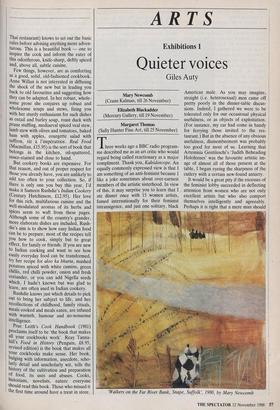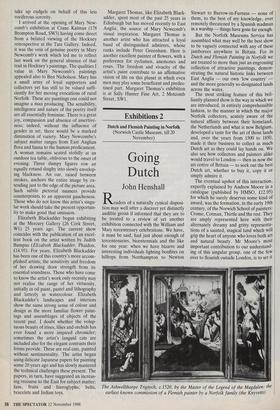ARTS
Exhibitions 1
Quieter voices
Giles Auty
Mary Newcomb (Crane Kalman, till 26 November) Elizabeth Blackadder (Mercury Gallery, till 19 November) Margaret Thomas (Sally Hunter Fine Art, till 25 November)
Three weeks ago a BBC radio program- me described me as an art critic who would regard being called reactionary as a major compliment. Thank you, Kaleidoscope. An equally commonly expressed view is that I am something of an anti-feminist because I like a joke sometimes about over-earnest members of the artistic sisterhood. In view of this, it may surprise you to learn that I ate dinner once with 15 women artists, famed internationally for their feminist intransigence, and just one solitary, black American male. As you may imagine, straight (i.e. heterosexual) men came off pretty poorly in the dinner-table discus- sions. Indeed, I gathered we were to be tolerated only for our occasional physical usefulness, or as objects of exploitation. (For instance, my car had come in handy for ferrying those invited to the res- taurant.) But in the absence of any obvious usefulness, dismemberment was probably too good for most of us. Learning that Artemisia Gentileschi's 'Judith Beheading Holofernes' was the favourite artistic im- age of almost all of those present at the table, I began eyeing the sharpness of the cutlery with a certain new-found anxiety.
It would be a great pity if the excesses of the feminist lobby succeeded in deflecting attention from women who are not only excellent artists but who also comport themselves intelligently and agreeably. Perhaps it is right that a mere man should 'Walkers on the Far River Bank, Snape, Suffolk', 1980, by Mary Newcomb take up cudgels on behalf of this less vociferous sorority.
I arrived at the opening of Mary New- comb's exhibition at Crane Kalman (178 Brompton Road, SW3) having come direct from a belated viewing of the Hockney retrospective at the Tate Gallery. Indeed, it was the vein of genuine poetry in Mary Newcomb's work which led me to reflect last week on the general absence of that trait in Hockney's paintings. The qualities I value in Mary Newcomb's paintings appealed also to Ben Nicholson. Mary has a small army of loyal supporters and collectors yet has still to be valued suffi- ciently for her moving evocations of rural Norfolk. These are paintings one could not imagine a man producing. The sensibility, intelligence and nature of the poetry itself are all essentially feminine. There is a great joy, compassion and absence of assertive- ness; indeed, without the influence of gender in art, there would be a marked diminution of variety. Mary Newcombe's subject matter ranges from East Anglian flora and fauna to the human predicament. A woman remains seated stolidly at an outdoor tea table, oblivious to the onset of evening. Three dumpy figures row an equally rotund dinghy into slowly envelop, ing blackness. An oar, raised between strokes, anchors the entire image by ex- tending just to the edge of the picture area. Such subtle pictorial nuances provide counterpoints to an apparent gaucheness. Those who do not know this artist's singu- lar work should take the present opportun- ity to make good that omission.
Elizabeth Blackadder began exhibiting at the Mercury Gallery (26 Cork Street, W1) 25 years ago. The current show coincides with the publication of an excel- lent book on the artist written by Judith Bumpus (Elizabeth Blackadder, Phaidon, f14.95). For years, Elizabeth Blackadder has been one of this country's more accom- plished artists; the sensitivity and freedom of her drawing draw strength from its essential soundness. Those who have come to know the artist's work only recently may not realise the range of her virtuosity, initially in oil paint, pastel and lithography and latterly in watercolour. Elizabeth Blackadder's landscapes and interiors show the same strong sense of colour and design as the more familiar flower paint- ings and assemblages of objects of the recent past. I doubt whether the volup- tuous beauty of irises, lilies and orchids has ever found a more inspired chronicler; sometimes the artist's languid cats are included also for the elegant contrasts their forms provide. These are real cats, painted without sentimentality. The artist began using delicate Japanese papers for painting some 20 years ago and has slowly mastered the technical challenges these present. The papers, in turn, have suggested an increas- ing recourse to the East for subject matter: fans, fruits and hieroglyphs; belts, bracelets and Indian toys. Margaret Thomas, like Elizabeth Black- adder, spent most of the past 25 years in Edinburgh but has moved recently to East Anglia, the source of Mary Newcomb's visual inspiration. Margaret Thomas is another artist who has attracted a loyal band of distinguished admirers, whose ranks include Peter Greenham. Here is another excellent painter of flowers, with a preference for cyclamen, anemones and roses. The freedom and vivacity of the artist's paint contribute to an affirmative vision of life on this planet in which even men may play some beneficent and predes- tined part. Margaret Thomas's exhibition is at Sally Hunter Fine Art, 2 Motcomb Street, SW1.











































































 Previous page
Previous page